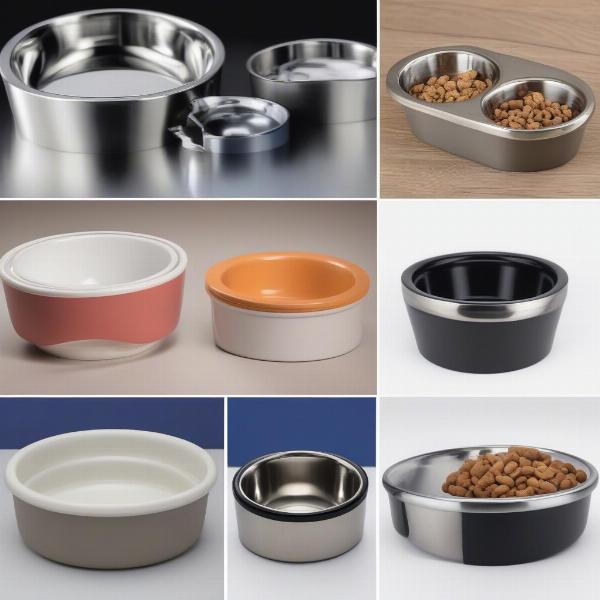Elevated dog food bowls have become increasingly popular, but does raising your dog’s dinner really offer any benefits? This article will delve into the world of elevate dog food, exploring the potential advantages and disadvantages, and helping you decide if it’s the right choice for your furry friend. We’ll cover everything from the science behind elevated feeders to practical tips for choosing the perfect one.
The Pros and Cons of Elevated Dog Food
Elevated dog feeders, often referred to as raised dog bowls, involve placing food and water bowls on a stand, raising them off the floor. While seemingly simple, this change can have a significant impact on some dogs. Let’s explore the potential benefits:
- Improved Digestion: For some dogs, eating from an elevated position can ease the process of moving food from the esophagus to the stomach, potentially reducing instances of regurgitation and promoting better digestion. This is particularly relevant for deep-chested breeds prone to bloat.
- Joint Health: Senior dogs or those with arthritis may find it easier and more comfortable to eat from a raised bowl, reducing strain on their neck, back, and joints.
- Cleaner Eating Area: Elevated bowls can help keep the eating area cleaner by preventing food spillage and reducing the dog’s need to “hunt” for kibble scattered across the floor.
- Better Posture: An elevated feeder can encourage a more upright eating posture, which can be beneficial for dogs with mobility issues.
However, there are also potential downsides to consider:
- Bloat Risk (In Some Cases): While often touted as a bloat preventative, some studies suggest that elevated feeders might actually increase the risk of bloat, particularly in large, deep-chested breeds. This is a complex issue and more research is needed.
- Stability: It’s crucial to choose a sturdy, well-designed elevated feeder to prevent tipping and spills, especially for enthusiastic eaters.
- Cost: Elevated feeders can be more expensive than traditional bowls.
- Adjustment Period: Some dogs may take time to adjust to eating from a raised bowl.
Choosing the Right Elevated Dog Food Bowl
If you decide that an elevated feeder is right for your dog, choosing the correct one is essential. Consider the following factors:
- Height: The bowl should be at a comfortable height for your dog to reach without straining. A good rule of thumb is to measure from the floor to your dog’s lower chest and subtract a few inches.
- Size: The bowl should be appropriately sized for your dog’s breed and food intake.
- Material: Opt for durable, easy-to-clean materials like stainless steel or ceramic.
- Stability: A stable base is crucial to prevent tipping. Look for feeders with non-slip feet.
 Choosing the Right Elevated Dog Bowl
Choosing the Right Elevated Dog Bowl
Is an Elevated Dog Food Bowl Right for My Dog?
“Not every dog needs an elevated feeder,” says Dr. Emily Carter, DVM, a veterinary specialist in canine nutrition. “While they can be beneficial for some, they are not a one-size-fits-all solution. It’s important to consider your individual dog’s needs and health status.”
Transitioning to an Elevated Feeder
Introducing an elevated feeder should be a gradual process. Start by placing the new feeder next to your dog’s existing bowl. Once your dog is comfortable eating from the elevated feeder, you can remove the old bowl.
Conclusion
Elevated dog food bowls can offer several advantages, particularly for senior dogs, dogs with arthritis, and some deep-chested breeds. However, it’s crucial to weigh the potential pros and cons and consult with your veterinarian to determine if an elevated feeder is the best choice for your individual dog. Careful consideration of factors like height, size, material, and stability will help you select the perfect elevated feeder for your canine companion.
FAQ
- Do elevated dog bowls prevent bloat? The relationship between elevated feeders and bloat is complex and not fully understood. While they may be helpful for some dogs, they may increase the risk in others. Consult with your veterinarian.
- What height should my dog’s elevated feeder be? Measure from the floor to your dog’s lower chest and subtract a few inches.
- What material is best for an elevated dog bowl? Stainless steel and ceramic are durable and easy to clean.
- Are elevated feeders suitable for all dog breeds? While generally safe, consult your veterinarian, especially for deep-chested breeds.
- How do I transition my dog to an elevated feeder? Gradually introduce the new feeder alongside the old one.
- Can puppies use elevated feeders? Yes, but ensure the height is appropriate for their size.
- Where can I buy a quality elevated dog food bowl? Pet supply stores and online retailers offer a wide selection.
About ILM Dog
ILM Dog is your go-to resource for expert advice on all aspects of dog care, from breed selection and health to training, nutrition, and product recommendations. We provide practical, trustworthy information for dog owners of all experience levels. Whether you’re a seasoned dog parent or just starting your journey, ILM Dog is here to help you provide the best possible care for your furry friend. Contact us at [email protected] or +44 20-3965-8624 for personalized guidance and support.